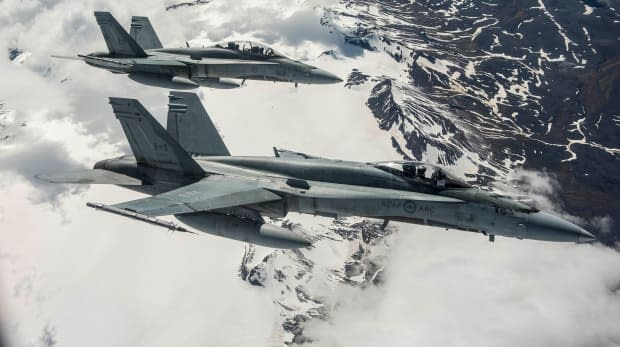Hear a roar over Yellowknife? That's an Arctic military exercise
Despite 2020's apocalyptic leanings, that thunderous sound in the sky over Yellowknife is not the apocalypse: it's a military exercise.
The North American Aerospace Defense Command (NORAD) is conducting air defence exercises that started Aug. 17 and run until Aug. 21.
In recent months, NORAD has been conducting more Arctic air patrols. They've combined Canadian and U.S. air force assets in the N.W.T. to extend their reach from the Beaufort Sea to Thule, Greenland, said NORAD spokesperson Capt. Cameron Hillier.
They're preparing for a number of scenarios: violations of airspace restrictions, hijackings and responding to unknown aircraft.
Hillier said there is "increasing competition from adversaries" who are edging into the Arctic.
With a greater military presence from both Arctic and non-Arctic nations, as well as non-military presence from commercial and private interests, there is a "need to exercise sovereignty over those areas," said Hillier.

The military is also practising aerial refueling, tracking and monitoring air space, and finding ways to intercept aircraft.
NORAD routinely intercepts Russian aircraft entering NORAD zones between Alaska and Canada's Arctic, said Hillier.
When an unknown aircraft flies toward those zones, it triggers a military response long before that aircraft can enter Canadian or U.S. airspace, which is within 12 nautical miles of each country's coastline.
For this exercise, the planes are flying out of Cold Lake, Alta., and Yellowknife.
The exercise involves a Royal Canadian Air Force CF-18 fighter aircraft coming out of Cold Lake. They'll also use a CP-140 long-range patrol aircraft, a CC-150T air refueler to practise aerial refueling.
The military also transported U.S. Air Force F-15 fighter aircraft from California, a KC-10 refueler, and C-17 transport aircraft.
COVID-19 precautions
All of the flights are over sparsely populated Arctic areas and at high altitudes. The most activity the public is likely to notice is coming out of Yellowknife.
Military personnel coming from the U.S. need two negative COVID-19 tests before they come to Canada, and then they are isolated on a base.
Where physical distancing is not possible, they are wearing masks.
Hillier said NORAD wants to dispel false speculation online that the exercises are related to the U.S. and Canada's COVID-19 response.
"This exercise is in no way related to the government of Canada or United States' response to COVID-19," a news release from NORAD stated.

